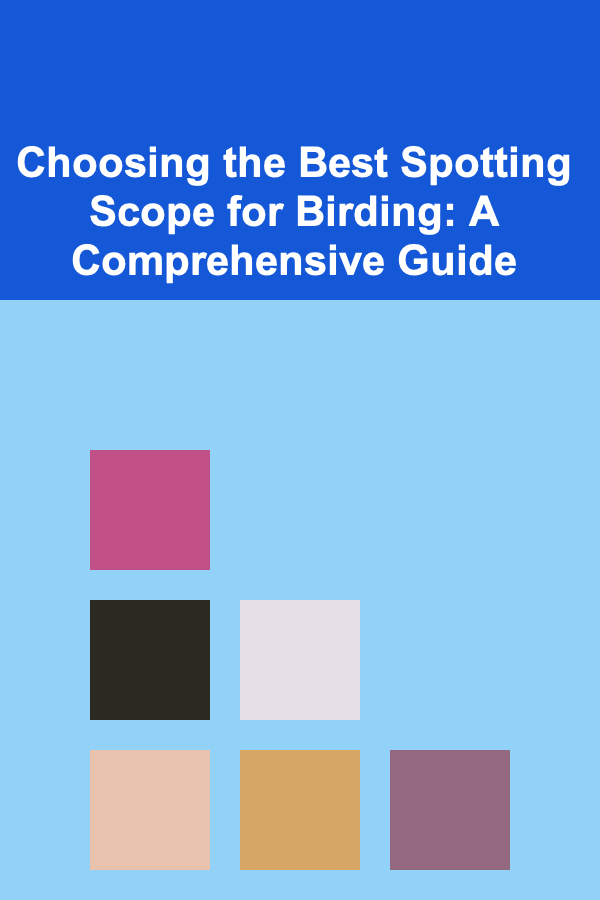
Choosing the Best Spotting Scope for Birding: A Comprehensive Guide
ebook include PDF & Audio bundle (Micro Guide)
$12.99$9.99
Limited Time Offer! Order within the next:

Birding is a rewarding hobby that connects us with nature and allows us to appreciate the beauty and diversity of avian life. While binoculars are essential for any birder, a spotting scope can significantly enhance the experience, particularly when observing distant or elusive birds. A spotting scope acts like a telephoto lens for your eyes, offering magnified views that reveal intricate details and allowing for identification at greater ranges. However, selecting the right spotting scope can be daunting, given the plethora of models available with varying features and price points. This comprehensive guide will delve into the key factors to consider when choosing a spotting scope for birding, helping you make an informed decision that suits your needs and budget.
Understanding Spotting Scope Basics
Before diving into specific models, it's crucial to understand the fundamental components and features that define a spotting scope. These include the objective lens diameter, magnification range, optical quality, body design, and overall ergonomics.
Objective Lens Diameter: Gathering Light
The objective lens is the large lens at the front of the spotting scope. Its diameter, measured in millimeters (mm), is a primary determinant of the scope's light-gathering ability. A larger objective lens gathers more light, resulting in brighter and clearer images, especially in low-light conditions such as dawn, dusk, or heavily shaded areas. This is particularly important for birding, as many birds are most active during these times. Common objective lens sizes for birding spotting scopes range from 50mm to 100mm.
Smaller Objective Lenses (50-65mm): These scopes are lighter and more portable, making them ideal for birders who frequently hike or travel. However, they gather less light, potentially compromising image brightness and clarity in challenging lighting conditions.
Mid-Sized Objective Lenses (70-85mm): This range represents a good balance between portability and light-gathering ability. They are a popular choice for general birding and offer acceptable performance in most lighting conditions.
Larger Objective Lenses (85-100mm): These scopes provide the brightest and clearest images, maximizing detail and allowing for comfortable viewing even in low light. However, they are significantly heavier and bulkier, requiring a sturdy tripod and potentially limiting portability.
Considerations: The ideal objective lens size depends on your typical birding environment and how much weight you're willing to carry. If you primarily bird in open areas with plenty of sunlight, a smaller objective lens might suffice. However, if you frequently bird in forests, wetlands, or at dawn and dusk, a larger objective lens is highly recommended.
Magnification: Bringing Birds Closer
Spotting scopes typically feature variable magnification eyepieces, allowing you to adjust the level of zoom. Magnification is expressed as a range, such as 20-60x or 25-75x. The first number indicates the minimum magnification, while the second number indicates the maximum magnification.
Low Magnification (20-30x): Provides a wider field of view, making it easier to locate and track moving birds. It also offers a brighter and more stable image, as higher magnifications amplify any image shake. Lower magnification is often preferable in situations where birds are relatively close or when searching for birds in a large area.
High Magnification (50-75x or higher): Allows you to see intricate details and identify birds at greater distances. However, high magnification also reduces the field of view, making it harder to find birds, and amplifies image shake, requiring a very stable tripod.
Considerations: While high magnification might seem desirable, it's important to remember that image quality degrades as magnification increases. Atmospheric conditions, such as heat shimmer, can also significantly affect image clarity at high magnification. A good spotting scope will provide sharp images at lower magnifications and maintain acceptable image quality at higher magnifications. A magnification range of 20-60x or 25-75x is generally sufficient for most birding applications. Avoid scopes with excessively high maximum magnifications (e.g., 80x or higher) unless you plan on using them only under ideal viewing conditions.
Optical Quality: The Heart of the Scope
The optical quality of a spotting scope is paramount to its performance. High-quality optics produce sharp, bright, and clear images with accurate color rendition. Several factors contribute to optical quality, including:
Glass Type: The type of glass used in the lenses significantly affects image quality. Extra-low dispersion (ED) glass, also known as fluorite glass, is highly desirable as it minimizes chromatic aberration (color fringing), resulting in sharper and more accurate images. ED glass is more expensive than standard optical glass, but the improvement in image quality is often worth the investment.
Coatings: Lens coatings are applied to the lens surfaces to reduce reflections and increase light transmission. Multi-coated lenses are superior to coated lenses, as they have multiple layers of coatings on all air-to-glass surfaces. Fully multi-coated lenses offer the best performance, maximizing light transmission and minimizing glare.
Prisms: Spotting scopes use prisms to invert the image and correct its orientation. There are two main types of prisms: Porro prisms and roof prisms. Porro prisms offer excellent image quality and are typically found in more affordable spotting scopes. Roof prisms are more compact and allow for a slimmer scope design. High-quality roof prisms use phase-correction coatings to minimize internal reflections and improve image contrast and resolution. BaK-4 glass is generally preferred for prisms due to its higher refractive index and lower light scattering.
Considerations: Optical quality is difficult to assess without actually looking through the scope. Read reviews, compare specifications, and, if possible, try out different models in person. Look for scopes with ED glass, fully multi-coated lenses, and high-quality prisms. Don't be afraid to spend a little more for better optics, as it will significantly enhance your birding experience.
Body Design: Straight vs. Angled
Spotting scopes are available in two main body designs: straight and angled.
Straight Spotting Scopes: The eyepiece is aligned directly with the objective lens. Straight scopes are generally easier to aim and locate birds quickly, especially at close range. They are also more intuitive to use and require less adjustment on the tripod. However, they can be less comfortable to use for extended periods, especially when viewing objects at high angles.
Angled Spotting Scopes: The eyepiece is angled at 45 or 90 degrees relative to the objective lens. Angled scopes are more comfortable to use for extended periods, especially when viewing objects at high angles or when sharing the scope with multiple people of different heights. They also allow for a lower tripod height, which can improve stability in windy conditions. However, they can be more difficult to aim and require more practice to locate birds quickly.
Considerations: The choice between straight and angled depends on personal preference and intended use. If you primarily bird from a standing position or share the scope with others, an angled scope might be more comfortable. If you prioritize ease of aiming and quick target acquisition, a straight scope might be preferable. Many birders find that an angled scope is more versatile for a wider range of situations.
Waterproof and Fogproof: Protecting Your Investment
Birding often takes place in unpredictable weather conditions, so it's essential to choose a spotting scope that is waterproof and fogproof. Waterproof scopes are sealed to prevent water from entering the internal components, protecting them from damage. Fogproof scopes are purged with nitrogen or argon gas to prevent internal fogging, ensuring clear views even in humid or rapidly changing temperatures.
Considerations: Look for scopes that are explicitly stated to be waterproof and fogproof. Check the manufacturer's specifications for the level of waterproofness (e.g., IPX7 or IPX8). A good warranty is also a good indicator of confidence in the product's weather resistance.
Focusing Mechanism: Smooth and Precise
The focusing mechanism should be smooth, precise, and easy to operate, even with gloves on. Spotting scopes typically have either a single focusing knob or a dual-focusing system with separate knobs for coarse and fine adjustments. A dual-focusing system allows for more precise focusing, especially at high magnifications.
Considerations: Try out the focusing mechanism in person, if possible, to ensure it feels comfortable and responsive. Look for a focusing knob that is large and easy to grip, even with gloves. A dual-focusing system is generally preferred for higher-end spotting scopes.
Essential Accessories
In addition to the spotting scope itself, several accessories can enhance your birding experience.
Tripod: Stability is Key
A stable tripod is essential for using a spotting scope, especially at higher magnifications. A flimsy tripod will amplify image shake, making it difficult to see details and identify birds. Look for a tripod that is sturdy, lightweight, and easy to adjust. Carbon fiber tripods are lighter and more vibration-resistant than aluminum tripods, but they are also more expensive. A good tripod head is also important, as it allows you to smoothly pan and tilt the scope. Ball heads are popular for their flexibility, while pan-and-tilt heads offer more precise control.
Considerations: Choose a tripod that is tall enough to allow you to view comfortably without having to hunch over. Consider the weight capacity of the tripod and ensure it can handle the weight of your spotting scope and other accessories. A good tripod is a long-term investment that will significantly improve your birding experience.
Eyepieces: Matching the View to Your Needs
While most spotting scopes come with a standard zoom eyepiece, you can often purchase additional eyepieces to suit specific viewing needs. Fixed-magnification eyepieces typically offer better image quality than zoom eyepieces, especially at higher magnifications. Wide-angle eyepieces provide a wider field of view, making it easier to locate and track birds.
Considerations: Consider purchasing a fixed-magnification eyepiece for situations where image quality is paramount. A wide-angle eyepiece can be helpful for searching for birds in large areas or for observing birds in flight.
Stay-On Case: Protection and Convenience
A stay-on case protects your spotting scope from scratches, dust, and minor impacts. It also allows you to use the scope without having to remove the case, providing added convenience. Look for a stay-on case that is made of durable material and fits your scope snugly.
Considerations: A stay-on case is a relatively inexpensive accessory that can significantly extend the life of your spotting scope.
Digital Camera Adapter: Digiscoping
A digital camera adapter allows you to attach a digital camera or smartphone to your spotting scope, enabling you to take photos and videos of birds at high magnification. This technique, known as digiscoping, can produce impressive results, allowing you to capture images that would be impossible with a standard camera lens.
Considerations: Digiscoping requires a sturdy tripod and a stable camera adapter. The quality of the images will depend on the quality of your spotting scope, camera, and adapter. It takes practice to master digiscoping, but the results can be well worth the effort.
Choosing the Right Spotting Scope: A Step-by-Step Approach
Selecting the best spotting scope for birding involves a systematic approach that considers your specific needs, budget, and viewing conditions.
- Determine Your Budget: Spotting scopes range in price from a few hundred dollars to several thousand dollars. Set a budget before you start shopping to narrow down your options.
- Identify Your Primary Birding Environments: Consider the types of environments where you will be using the scope most often. If you primarily bird in open areas with plenty of sunlight, a smaller objective lens might suffice. If you frequently bird in forests, wetlands, or at dawn and dusk, a larger objective lens is recommended.
- Decide on Straight vs. Angled Body Design: Consider your personal preferences and intended use. If you prioritize ease of aiming and quick target acquisition, a straight scope might be preferable. If you value comfort and versatility, an angled scope might be a better choice.
- Research and Compare Models: Read reviews, compare specifications, and visit online forums to gather information about different models. Pay attention to user feedback regarding image quality, build quality, and overall performance.
- Try Before You Buy (If Possible): If possible, visit a local optics store and try out different models in person. This will allow you to assess the image quality, focusing mechanism, and overall ergonomics.
- Consider Accessories: Factor in the cost of essential accessories, such as a tripod, stay-on case, and digital camera adapter (if desired).
- Read the Warranty: Ensure the spotting scope has a good warranty covering defects in materials and workmanship.
Top Spotting Scope Brands for Birding
Several reputable brands manufacture high-quality spotting scopes for birding. Some of the most popular and well-regarded brands include:
- Swarovski Optik: Known for their exceptional optical quality and premium build. They are at the top of the price range.
- Leica: Another top-tier brand with exceptional optics and durable construction.
- Zeiss: Offers a range of spotting scopes with excellent image quality and innovative features.
- Nikon: A trusted brand with a wide selection of spotting scopes to suit different budgets and needs.
- Vortex Optics: Provides excellent value for money, offering high-quality optics and a lifetime warranty.
- Bushnell: Offers a variety of spotting scopes at affordable prices, suitable for beginners and casual birders.
- Celestron: Known for their telescopes, Celestron also makes decent spotting scopes that are generally more affordable.
Final Thoughts
Choosing the best spotting scope for birding is a personal decision that depends on your individual needs, budget, and viewing preferences. By understanding the key features and factors discussed in this guide, you can make an informed decision and select a spotting scope that will enhance your birding experience for years to come. Remember to prioritize optical quality, build quality, and overall ergonomics, and don't be afraid to invest in a good tripod and other essential accessories. Happy birding!

How to Choose the Right Color Palette for Your Dining Room
Read More
How to Plan a Fun Game Night Party for All Ages
Read More
How to Stage Outdoor Spaces to Boost Your Home's Curb Appeal
Read More
How to Use Labels to Keep Supplies Sorted
Read More
Marketing Strategies for Selling Digital Recipe Books
Read More
How To Explore Deep-Sky Objects with Binoculars
Read MoreOther Products

How to Choose the Right Color Palette for Your Dining Room
Read More
How to Plan a Fun Game Night Party for All Ages
Read More
How to Stage Outdoor Spaces to Boost Your Home's Curb Appeal
Read More
How to Use Labels to Keep Supplies Sorted
Read More
Marketing Strategies for Selling Digital Recipe Books
Read More